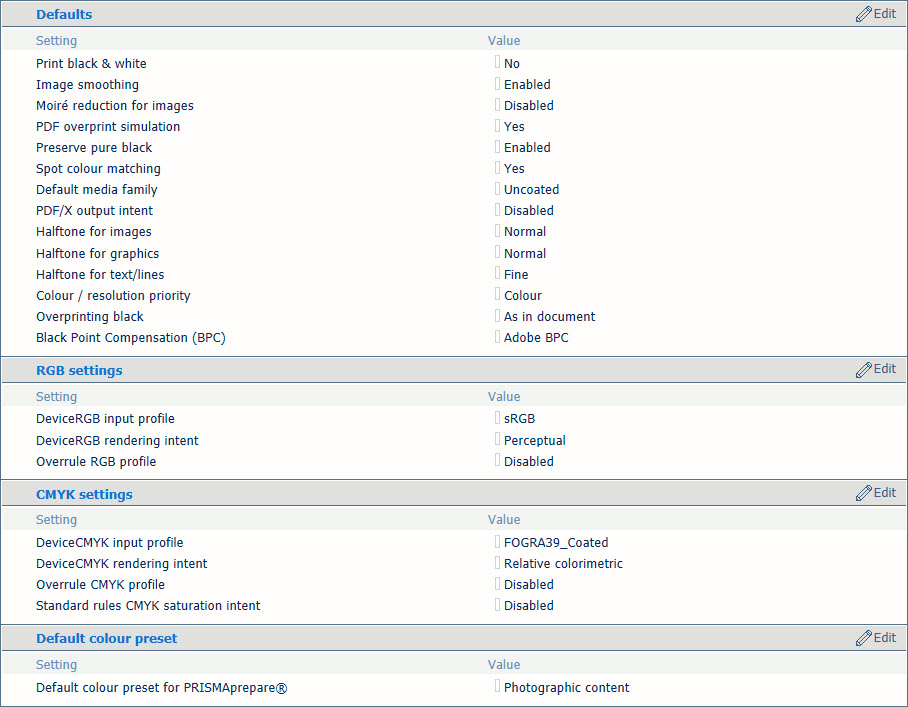

This topic contains the following instructions.
Go to the color defaults
Define the color defaults
Define Device RGB input profiles
Define Device CMYK input profiles
Open the Settings Editor and go to: .


Use the [Print black & white] option to indicate how jobs are printed: in black and white or in color.
Use the [Image smoothing] option to prevent unsmooth lines and image blocks in the document. This occurs when source objects have a lower resolution than the printer. The [Image smoothing] interpolation method only affects images below 300 dpi. .
Use the [Moiré reduction for images] option to apply a Moiré reduction algorithm to enhance photographic images. Please note that when images have a resolution below 300 dpi, the Moiré reduction only takes effect when the [Image smoothing] option is enabled.
Use the [PDF overprint simulation] option to make opaque objects look transparent. Underlying objects become visible. If this option is disabled, the colors on top will knock out all underlying colors.
Use the [Preserve pure black] option to apply pure black preservation when possible. Pure black preservation means that the color black is composed of 100% K ink. When pure black preservation is not possible or disabled, the color black is composed of a mixture of two or more C, M, Y, and K inks.
Use the [Spot color matching] option to enable or disable spot color matching. If a source file contains a spot color, the printer must know the spot color definition to exactly print the required color.
Use the [Default media family] option to define the default media family for print jobs that arrive without media family information.
Use the [Use PDF/X output intent] option to indicate if PDF source files are printed according to their embedded output intent. PDF/X specifies the printing conditions for which a PDF/X file is created. These printing conditions are called output intents. The printer can handle PDF/X compliant PDF source files. Then, the output intent overrules the DeviceCMYK rendering intent and DeviceCMYK input profile.
Use the [Halftone for images] option to change the default halftone for images.
[Normal]: for sharper texts or improvement of the color gradient in color areas.
[Fine]: for text, images, and graphics.
[Error diffusion]
Use the [Halftone for graphics] option to change the default halftone for graphics.
Use the [Halftone for text/lines] option to change the default halftone for text and lines.
Use the [Color / resolution priority] option if graphic objects with a high toner density may appear blurry at the edges of the graphic. Use this setting for sharp edges. The graphic objects may become less saturated.
Use the [Overprinting black] option to force the printer to print pure black text and graphics over the background color. The [Overprinting black] prevents that white lines appear around black characters and graphics.
[As in document]: overprinting black is not applied.
[Enabled for text]: overprinting black is applied to texts.
[Enabled for text and graphics]: overprinting black is applied to texts and graphics.
Use the [Black Point Compensation (BPC)] option applies to the relative colorimetric rendering intent. Details in dark regions of the document can be lost with the standard color conversion. The Black Point Compensation aligns the darkest level of black achievable (black point) of the source to the darkest level of black achievable on the printer.
[Disabled]: Black Point Compensation is not applied.
[Adobe BPC]: the Adobe implementation of [Black Point Compensation (BPC)].
[Enhanced BPC]: when the black point in the document is rather light, select [Enhanced BPC].
The Settings Editor stores the DeviceRGB input profiles from which you can select a default DeviceRGB input profile.
Use the [DeviceRGB input profile] option to select the default DeviceRGB input profile.
Use the [DeviceRGB rendering intent] option to select the default DeviceRGB rendering intent that defines the color conversion strategy for out-of-gamut colors.
Use the [Overrule RGB profile] option to indicate if the embedded DeviceRGB input profile is overruled or not.
The Settings Editor stores the DeviceCMYK input profiles from which you can select a default DeviceCMYK input profile.
Use the [DeviceCMYK input profile] option to select the default DeviceCMYK input profile.
Use the [DeviceCMYK rendering intent] option to select the default DeviceCMYK rendering intent that defines the color conversion strategy for out-of-gamut colors.
Use the [Overrule CMYK profile] option to indicate if the embedded DeviceCMYK input profile is overruled or not.
Use the [Standard rules CMYK saturation intent] option to indicate if the standard ICC color management rules of the CMYK saturation intent must be applied. For the CMYK saturation intent, the printer by default maps pure (100%) C, M, Y and K input colors into pure C, M, Y and K output colors. However, it can be required that the standard ICC color management rules must be used without an improvement of the color management of the printer.